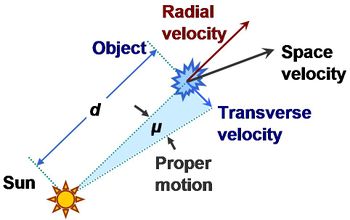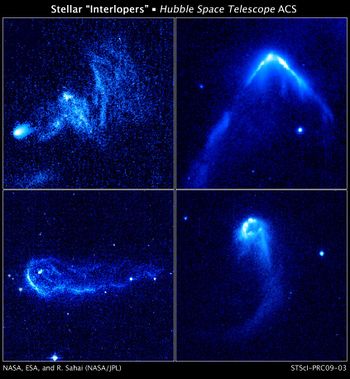علم حركة النجوم
في علم الفلك علم حركة النجوم المجردة (أو كيناماتيكا النجوم Stellar kinematics) هو علم حركة النجوم من دون معرفة سبب حركتها ؛ هذا بالمقارنة بعلم حركة النجوم "ديناميكا النجوم" Stellar daynamics التي يكون السبب فيها هو قوة الثقالية.عن طريق دراسة حركة نجم بالنسبة للشمس يمكن استنباط معلومات عن مصدر النجم وعمره ، وكذلك معرفة تركيبة وتطور المنطقة المحيطة له في المجرة ، درب التبانة.
فقد استتب في علم الفلك أن النجوم تنشأ من سحب جزيئية تسمى "منشئات النجوم". ومن بين النجوم التي تنشأ في سحابة جزيئية تكون تجمعات نجمية مفتوحة تحوي عشرات الألاف من النجوم. تنفصل النجوم في العنقود عن بعضها البعض . وتصبح النجوم التي غادرت مركز العنقود أعضاءا من تجمع نجمي . ويسمى ما بقي في العنقود النجمي " مجموعة متحركة " وهي تتحرك بأعضائها متلازمين خلال مجرة درب التبانة.
السرعة الفضائية

(الشكل يبين أن الزاوية μ انزاحت خلال وحدة الزمن بالسرعة المماسة tangential velocity vt.)
مركبة سرعة النجم في اتجاه الشمس أو المبتعدة عن الشمس تسمى سرعة شعاعية ؛ ويمكن قياسها عن طريق انزياح الطيف فيما يسمى إنزياح دوبلر. أما المركبة العرضية لسرعة النجم فهي تسمى سرعة خاصة ويمكن تعيينها عن طريق قياسها عدة مرات على فترات وتعيين مواقعها بالنسبة على نجوم خلفها أكثر بعدا عن الأرض. وبتعيين بعد نجم عنا بواسطة طريقة التزيح أو بطريقة أخرى يمكن تعيين سرعة النجم في الفضاء. [1] وتكون تلك السرعة هي السرعة الحقيقية للنجم بالنسبة للشمس ، أو بالنسبة إلى ما يسمى المرجع المحلي المستقر local standard of rest ؛ وهو في العادة موقع الشمس التي تتبع مسارا دائريا حول مركز المجرة وسرعتها تماثل السرعات المتوسطة للنجوم المحيطة بالشمس . .[2]
وتسمى حركة الشمس بالنسبة إلى المرجع المحلي المستقر حركة الشمس الخاصة.
مركبات السرعة الفضائية في نظام الإحداثيات لمجرة درب التبانة تسمى عادة يرمز لها عادة بـ U،و V، وW وهي سرعات تعطى بوحدة كيلومتر في الثانية، وبحيث تكون السرعة U موجبة في اتجاه مركز المجرة ، والسرعة V تكون موجبة في اتجاه دورة المجرة ، والسرعة W مختارة لتكون في إتجاه القطب الشمالي للمجرة. [3]
وطبقا لهذا التعريف تكون الحركة الخاصة للشمس بالنسبة إلى المرجع المحلي المستقر ، هي"[4]
- (U, V, W) = (11.1, 12.24, 7.25) km/s,[5])
ويمكن تقسيم النجوم في المجرة إلى جيلين ، بناءا على مقدار معدنيتها أو نسب العناصر ذات عدد ذري أكبر من الهيليوم . ومن ضمن النجوم القريبة منا فقد وجد أن الجيل I ونجومه ذات معدنية عالية فهي ذات سرعات منخفضة بالنسبة لنجوم أطول عمرا (الجيل II من النجوم). تلك النجوم الأخيرة لها مدارات بيضوية ويميل مسواها قليلا عن مستوى مجرة الدرب التبانة.[6]
وقد أدى مقارنة كيناماتيكا النجوم القريبة إلى التعرف على النجوم المجتمعة stellar association. وهي عادة نجوم تشترك في نقطة لأصل نشأتها في سحابة جزيئية. .[7]
في درب التبانة توجد ثلاثة مركبات رئيسية لكيناماتيكا النجوم: القرص ، والهالة (أي الكرة الغازية المحيطة بالقرص) ، والحوصلة أو الضلع. وتلك المجموعات الحركية تتعلق بأجيال النجوم في مجرة درب التبانة، بحيث أنها تشكل علاقة بين الحركة والتركيب الكيميائي ؛ أي أنها تشير إلى آليات مختلفة لتكوينها. كما يمكن تقسيم الهالة إلى هالة داخلية وهالة خارجية، حيث يكون للهالة الداخلية حركة متوافقة مع حركة القرص ، بينما تكون الهالة الخارجية تتحرك بحركة تراجعية .[8]
نجوم تتحرك بسرعات كبيرة
طبقا للتعريف، النجم السريع هو نجم يتحرك بسرعة بين 65 كيلومتر/ الثانية إلى 100 كيلومتر/ الثانية بالنسبة لحركة النجوم الأخرى القريبة من الشمس. وتقسم الثلاثة أنواع للسرعات العالية إلى: نجوم شاردة ، ونجوم الهالة ، ونجوم فائقة السرعة.
النجوم المارقة

النجم الشارد هو نجم يتحرك في الفضاء بسرعة عالية غير عادية بالمقارنة بما يحيطه من وسط بين نجمي. وتكون الحركة الخاصة للنجم الشارد عادة متجهة بعيدا عن التجمع النجمي ، الذي كان النجم المارق عضوا فية قبل أن يُدفع خارجها .
توجد آليتان يمكنها التسبب في شرود نجم:
- الألية الأولى هو تقابل بين نظامين ثنائيين وعن طريق الخلخلة بينهما فيمكن شرود نجم منها بسرعة كبيرة.
- في الآلية الثانية : حدوث انفجار مستعر أعظم في نظام متعدد النجوم قد يتسبب في شرود بعض البقايا بسرعات عالية .[9][10]
ومع ان هذين الآليتين ممكنتين إلا أن علماء الفلك يرجحون آلية المستعر الأعظم حيث تشير الأرصاد إلى ذلك.
منالأمثلة على النجم الشارد نجد AE Aurigae و53 Arietis وMu Columbae، وكلهم يباعدون عن بعضهم البعض بسرعات تفوق 100 كيلومتر في الثانية (بالمقارنة بحركة الشمس فهي تتحرك بسرعة 20 كيلومتر /الثانية في المجرة بالمقارنة بمتوسط سرعة المحيط). وبتتبع حركتهم سابقا نجدهم يلتقون عند نقطة قريبة من سديم الجبار قبل نحو 2 مليون سنة.
وتشير الأرصاد إلى أن حلقة برنارد ما هي إلا بقايا مستعر تسبب في شرود نجوم أخرى.
مثال آخر نجده في الجرم السماوي الذي يصدر أشعة إكس وهو Vela X-1, حيث تشير تحليلات التقنية الرقمية للصور وجود موجة صدمية فائقة.
نجوم الهالة
 مقالة مفصلة: هالة المجرة
مقالة مفصلة: هالة المجرة
النجوم السريعة تكون عادة نجوم عتيقة لا تشترك مع الشمس في حركتها ولا مع معظم النجوم القريبة من الشمس حيث تتحرك الشمس والنجوم المجاورة في مدارات دائرية حول مركز المجرة . وتتحرك النجوم السريعة في مدارات بيضوية وليست دائرية مما يجعلهم يبتعدون إلى خارج مستوى اجرة درب التبانة. ومع أن سرعتهم المدارية لا تختلف عن سرعة دوران الأرض حول مركز المجرة إلا أن اختلاف مساراتهم ينشأ من سرعاتهم النسبية السريعة.
أمثلة على ذلك نجدها في نجوم الهالة وحركتهم خلال قرص المجرة بزوايا حادة . ومن ضمن تلك النجوم القريبة نجد نجم كابتين ذو السرعة العالية ، وهو أحد 45 نجما قريبين من الشمس. وتبلغ السرعة الشعاعية للنجم كبيرة −245 كيلومتر/الثانية ، وتبلغ مركبات سرعته الفضائية U = 19 km/s ،و V = -288 km/s ، وW = -52 km/s.
النجوم فائقة السرعة
نجوم السرعات الفائقة هي نجوم تفوق سرعاتها سرعات النجوم المعتادة في المجرة. وقد تصل سرعة تلك النجوم إلى سرعات تجعلها تغادر المجرة. .[11] النجوم في المجرة تكون سرعاتها في العادة حول 100 كيلومتر في الثانية ، بينما تصل سرعات النجوم الفائقة السرعة (وهي عادة تكون قريبة من مركز المجرة) إلى نحو 1000 كيلومتر في الثانية.
العاديات هي نجوم قديمة جدا تتحرك بسرعة عالية لا تشارك الشمس ومعظم النجوم المجاورة في حركتها, تتحرك بسرعة أكبر من 65 كم / ثانية إلى 100 كلم / ثانية وفقا لمتوسط حركة النجوم المجاورة للشمس، وليس لهذه النجوم عموما نفس اتجاه الحركة في الفضاء مثل الشمس في حركتها حول نواة درب التبانة بل تتحرك في مدرات إهليجية كبيرة غالبا تأخذهم خارج مستوى المجرة ، على الرغم من أن سرعاتها المدارية في المجرة قد لا تكون أسرع من الشمس ولكن مساراتها المختلفة تؤدي إلى السرعات النسبية العالية ،تدور الشمس حول مركز درب التبانة بسرعة تيبلغ حوالي 250 كيلومتر في الثانية ، وسرعة الإفلات من مجرة درب التبانة (310 كم/ث) ، ولو أن نجما تعدت سرعته سرعة الإفلات فإنه يترك مجرة درب التبانة، لأن جذب النجوم الأخرى له يصبح صغيراً بدرجة لا تكفي للاحتفاظ به في المجموعة، والعاديات ليست سابقة للشمس في حركتها وإنما تبقى في الغالب خلفها، من هذه النظرة فإن تسميتها بالنجوم البطيئة يمكن أن يكون مناسباً أكثر، وحركة هذه النجوم يغلب عليها الاتجاه إلى خارج نواة المجرة أو العكس ومن ذلك يبدو واضحاً أن العاديات تدور حول درب التبانة في مدارات بيضاوية ضخمة ، وربما خرجت هذه النجوم من نواة المجرة وتغطس فيها ثانية، وحتى الآن تم اكتشاف حوالي 600 عاديا .
مصدر السرعات الفائقة
يعتقد أن النجوم ذات السرعات الفائقة تأتي من تلاقي أنظمة نجمية ثنائية مع ثقب أسود فائق موجود في مركز مجرة درب التبانة. يلتقط الثقب الأسود أحد النجمين بينما ينطلق الآخر بسرعة رهيبة. في نفس الوقت لا يعني إلتقاط أحد النجمين "ابتلاعه" وإنما قد يأخذ مدار سريع حول الثقب الأسود . ولكن هذا لا يمكن حدوثه إلا في سقوط نظام النجمين من مكان بعيد عن الثقب الأسود ، بحيث يكتسبان سرعات تكفي لفرار "أحدهما" من الثقب الأسود .
Kinematic groups
A set of stars with similar space motion and ages is known as a kinematic group.[12] These are stars that could share a common origin, such as the evaporation of an open cluster, the remains of a star forming region, or collections of overlapping star formation bursts at differing time periods in adjacent regions.[13] Most stars are born within molecular clouds known as stellar nurseries. The stars formed within such a cloud compose gravitationally bound open clusters containing dozens to thousands of members with similar ages and compositions. These clusters dissociate with time. Groups of young stars that escape a cluster, or are no longer bound to each other, form stellar associations. As these stars age and disperse, their association is no longer readily apparent and they become moving groups of stars.
Astronomers are able to determine if stars are members of a kinematic group because they share the same age, metallicity, and kinematics (radial velocity and proper motion). As the stars in a moving group formed in proximity and at nearly the same time from the same gas cloud, although later disrupted by tidal forces, they share similar characteristics.[14]
الارتباطات النجمية
A stellar association is a very loose star cluster, whose stars share a common origin, but have become gravitationally unbound and are still moving together through space. Associations are primarily identified by their common movement vectors and ages. Identification by chemical composition is also used to factor in association memberships.
Stellar associations were first discovered by the Armenian astronomer Viktor Ambartsumian in 1947.[15] The conventional name for an association uses the names or abbreviations of the constellation (or constellations) in which they are located; the association type, and, sometimes, a numerical identifier.
الأنواع
Viktor Ambartsumian first categorized stellar associations into two groups, OB and T, based on the properties of their stars.[15] A third category, R, was later suggested by Sidney van den Bergh for associations that illuminate reflection nebulae.[16] The OB, T, and R associations form a continuum of young stellar groupings. But it is currently uncertain whether they are an evolutionary sequence, or represent some other factor at work.[17] Some groups also display properties of both OB and T associations, so the categorization is not always clear-cut.
OB associations

Young associations will contain 10 to 100 massive stars of spectral class O and B, and are known as OB associations. In addition, these associations also contain hundreds or thousands of low- and intermediate-mass stars. Association members are believed to form within the same small volume inside a giant molecular cloud. Once the surrounding dust and gas is blown away, the remaining stars become unbound and begin to drift apart.[18] It is believed that the majority of all stars in the Milky Way were formed in OB associations.[18] O-class stars are short-lived, and will expire as supernovae after roughly one million years. As a result, OB associations are generally only a few million years in age or less. The O-B stars in the association will have burned all their fuel within ten million years. (Compare this to the current age of the Sun at about five billion years.)
The Hipparcos satellite provided measurements that located a dozen OB associations within 650 parsecs of the Sun.[19] The nearest OB association is the Scorpius–Centaurus Association, located about 400 light-years from the Sun.[20]
Stellar streams
A stellar stream is an association of stars orbiting a galaxy that was once a globular cluster or dwarf galaxy that has now been torn apart and stretched out along its orbit by tidal forces.
المجموعات الحركية المعروفة
Some nearby kinematic groups include:[12]
- Local Association (Pleiades moving group)
- AB Doradus moving group
- Alpha Persei moving cluster
- Beta Pictoris moving group[21]
- Castor moving group
- Corona Australis association
- Eta Chamaeleontis cluster
- Hercules stream
- Hyades Stream
- IC 2391 supercluster (Argus Association)
- Kapteyn group[22]
- MBM 12 association
- Tucana-Horologium Association[21]
- TW Hydrae association[21]
- Ursa Major Moving Group
- Wolf 630 moving group[23]
- Zeta Herculis moving group
المراجع
- ^ "Stellar Motions (Extension)". Australia Telescope Outreach and Education. Commonwealth Scientific and Industrial Research Organisation. 2005-08-18. Retrieved 2008-11-19.
- ^ Fich, Michel; Tremaine, Scott (1991). "The mass of the Galaxy". Annual Review of Astronomy and Astrophysics. 29 (1): 409–445. Bibcode:1991ARA&A..29..409F. doi:10.1146/annurev.aa.29.090191.002205.
- ^ Johnson, Dean R. H.; Soderblom, David R. (1987). "Calculating galactic space velocities and their uncertainties, with an application to the Ursa Major group". Astronomical Journal. 93 (2): 864–867. Bibcode:1987AJ.....93..864J. doi:10.1086/114370.
- ^ Schönrich, Ralph; Binney, James (2010). "Local kinematics and the local standard of rest". Monthly Notices of the Royal Astronomical Society. 403 (4): 1829–1833. arXiv:0912.3693. Bibcode:2010MNRAS.403.1829S. doi:10.1111/j.1365-2966.2010.16253.x.
- ^ Dehnen, Walter; Binney, James J. (1999). "Local stellar kinematics from HIPPARCOS data". Monthly Notices of the Royal Astronomical Society. 298 (2): 387–394. arXiv:astro-ph/9710077. Bibcode:1998MNRAS.298..387D. doi:10.1046/j.1365-8711.1998.01600.x.
- ^ Johnson, Hugh M. (1957). "The Kinematics and Evolution of Population I Stars". Publications of the Astronomical Society of the Pacific. 69 (406): 54. Bibcode:1957PASP...69...54J. doi:10.1086/127012.
- ^ Elmegreen, B.; Efremov, Y. N. (1999). "The Formation of Star Clusters". American Scientist. 86 (3): 264. Bibcode:1998AmSci..86..264E. doi:10.1511/1998.3.264.
- ^ Carollo, Daniela; et al. (2007-12-13). "Two stellar components in the halo of the Milky Way". Nature. 450 (7172): 1020–1025. arXiv:0706.3005. Bibcode:2007Natur.450.1020C. doi:10.1038/nature06460. PMID 18075581.
- ^ Blaauw (1961), "On the origin of the O- and B-type stars with high velocities (the run-away stars), and some related problems" BAN 15, 265
- ^ Tauris & Takens (1998), "Runaway velocities of stellar components originating from disrupted binaries via asymmetric supernova explosions" A&A 330, 1047
- ^ "Two Exiled Stars Are Leaving Our Galaxy Forever". Space Daily. 2006-01-27. Retrieved 2009-09-24.
{{cite web}}: Unknown parameter|تاريخ الأرشيف=ignored (help); Unknown parameter|مسار الأرشيف=ignored (help) - ^ أ ب López-Santiago, J.; Montes, D.; Crespo-Chacón, I.; Fernández-Figueroa, M. J. (June 2006). "The Nearest Young Moving Groups". The Astrophysical Journal. 643 (2): 1160–1165. arXiv:astro-ph/0601573. Bibcode:2006ApJ...643.1160L. doi:10.1086/503183.
- ^ Montes, D.; et al. (November 2001). "Late-type members of young stellar kinematic groups – I. Single stars". Monthly Notices of the Royal Astronomical Society. 328 (1): 45–63. arXiv:astro-ph/0106537. Bibcode:2001MNRAS.328...45M. doi:10.1046/j.1365-8711.2001.04781.x.
- ^ Johnston, Kathryn V. (1995). "Fossil Signatures of Ancient Accretion Events in the Halo". The Astrophysical Journal. 465: 278. arXiv:astro-ph/9602060. Bibcode:1996ApJ...465..278J. doi:10.1086/177418.
- ^ أ ب Israelian, Garik (1997). "Obituary: Victor Amazaspovich Ambartsumian, 1912 [i.e. 1908] –1996". Bulletin of the American Astronomical Society. 29 (4): 1466–1467. Bibcode:1997BAAS...29.1466I.
- ^ Herbst, W. (1976). "R associations. I – UBV photometry and MK spectroscopy of stars in southern reflection nebulae". Astronomical Journal. 80: 212–226. Bibcode:1975AJ.....80..212H. doi:10.1086/111734.
- ^ خطأ استشهاد: وسم
<ref>غير صحيح؛ لا نص تم توفيره للمراجع المسماةMon R2 - ^ أ ب "OB Associations" (PDF). GAIA: Composition, Formation and Evolution of the Galaxy. 2000-04-06. Retrieved 2013-11-14.
- ^ de Zeeuw, P. T.; Hoogerwerf, R.; de Bruijne, J. H. J.; Brown, A. G. A.; et al. (1999). "A HIPPARCOS Census of the Nearby OB Associations". The Astronomical Journal. 117 (1): 354–399. arXiv:astro-ph/9809227. Bibcode:1999AJ....117..354D. doi:10.1086/300682.
- ^ Maíz-Apellániz, Jesús (2001). "The Origin of the Local Bubble". The Astrophysical Journal. 560 (1): L83–L86. arXiv:astro-ph/0108472. Bibcode:2001ApJ...560L..83M. doi:10.1086/324016.
- ^ أ ب ت Song, Inseok; et al. (December 2003). "New Members of the TW Hydrae Association, β Pictoris Moving Group, and Tucana/Horologium Association". The Astrophysical Journal. 599 (1): 342–350. Bibcode:2003ApJ...599..342S. doi:10.1086/379194.
- ^ Wylie-de Boer, Elizabeth; et al. (February 2010). "Evidence of Tidal Debris from ω Cen in the Kapteyn Group". The Astronomical Journal. 139 (2): 636–645. arXiv:0910.3735. Bibcode:2010AJ....139..636W. doi:10.1088/0004-6256/139/2/636.
- ^ McDonald, A. R. E.; Hearnshaw, J. B. (August 1983). "The Wolf 630 moving group of stars". Monthly Notices of the Royal Astronomical Society. 204 (3): 841–852. Bibcode:1983MNRAS.204..841M. doi:10.1093/mnras/204.3.841.
اقرأ أيضا
- نجم مارق
- حركة تراجعية
- نجم كابتين
- القاعدة أو بي 1
- مجرة قزمة الرامي
- منحني دوران مجرة
- تحرر النباض
- سرعة غريبة
وصلات خارجية
- ESO press release about runaway stars
- Entry in the Encyclopedia of Astrobiology, Astronomy, and Spaceflight
- Two Exiled Stars Are Leaving Our Galaxy Forever
- Entry in the Encyclopedia of Astrobiology, Astronomy, and Spaceflight
- Hypervelocity stars. I. The spectroscopic survey[dead link] information on HV 6 & HV 7
- Young stellar kinematic groups, David Montes, Departamento de Astrofísica, Universidad Complutense de Madrid.
